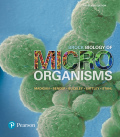
EBK BROCK BIOLOGY OF MICROORGANISMS
15th Edition
ISBN: 8220103633352
Author: Stahl
Publisher: PEARSON
expand_more
expand_more
format_list_bulleted
Question
Chapter 7.5, Problem 1MQ
Summary Introduction
Bactoprenol is a lipid carrier molecule present in the bacteria. It is synthesized by three different Lactobacilli species. It is hydrophobic in nature and it is a C55 isoprenoid. Bactoprenol is bonded to the N-acetyl glucosamine (NAG) and N-acetylmuramic acid (NAM) of the cell membrane. Therefore, these lipid carrier molecules remain in the cytoplasmic membrane at all the times.
Expert Solution & Answer
Want to see the full answer?
Check out a sample textbook solution
Students have asked these similar questions
The following table is from Kumar et. al. Highly Selective Dopamine D3 Receptor (DR) Antagonists and Partial Agonists Based on Eticlopride and the D3R Crystal Structure: New Leads for Opioid Dependence Treatment. J. Med Chem 2016.
The following figure is from Caterina et al. The capsaicin receptor: a heat activated ion channel in the
pain pathway. Nature, 1997. Black boxes indicate capsaicin, white circles indicate resinferatoxin.
You are a chef in a fancy new science-themed restaurant. You have a recipe that calls for 1 teaspoon of resinferatoxin, but you feel uncomfortable serving foods with "toxins" in them. How much capsaicin could you substitute instead?
What protein is necessary for packaging acetylcholine into synaptic vesicles?
Chapter 7 Solutions
EBK BROCK BIOLOGY OF MICROORGANISMS
Ch. 7.1 - What is the utility of a reporter gene?Ch. 7.1 - Prob. 2MQCh. 7.1 - Prob. 1CRCh. 7.2 - Prob. 1MQCh. 7.2 - Prob. 2MQCh. 7.2 - Prob. 1CRCh. 7.3 - What is the divisome?Ch. 7.3 - How does FtsZ find the cell midpoint of a...Ch. 7.3 - What is the role of the penicillin-binding protein...Ch. 7.4 - How does MreB control the shape of a rod-shaped...
Ch. 7.4 - What protein is thought to control the shape of...Ch. 7.4 - What relationships exist between cytoskeletal...Ch. 7.4 - What morphology do cells have that lack MreB or...Ch. 7.5 - Prob. 1MQCh. 7.5 - What is transpeptidation and why is it important...Ch. 7.5 - Prob. 1CRCh. 7.6 - How are different sets of genes expressed in the...Ch. 7.6 - Prob. 2MQCh. 7.6 - Prob. 1CRCh. 7.7 - Why are the levels of DnaA protein controlled...Ch. 7.7 - Prob. 2MQCh. 7.7 - Prob. 1CRCh. 7.8 - Prob. 1MQCh. 7.8 - What is the major transcriptional regulator that...Ch. 7.8 - What is meant by "patterning" during heterocyst...Ch. 7.9 - What are the four basic stages of biofilm...Ch. 7.9 - Besides autoinducer synthesis, what intracellular...Ch. 7.9 - What type of genes does c-di-GMP activate during...Ch. 7.10 - Describe two targets of antibiotics and discuss...Ch. 7.10 - Prob. 2MQCh. 7.10 - Prob. 3MQCh. 7.10 - Prob. 1CRCh. 7.11 - Is persistence a heritable trait?Ch. 7.11 - What prevents the toxin component of TA modules...Ch. 7.11 - Prob. 3MQCh. 7.11 - Prob. 1CRCh. 7 - If DnaA was not regulated in Escherichia coli and...Ch. 7 - Explain how cells exhibiting different phenotypes...Ch. 7 - Describe how you would genetically design a...
Knowledge Booster
Learn more about
Need a deep-dive on the concept behind this application? Look no further. Learn more about this topic, biology and related others by exploring similar questions and additional content below.Similar questions
- 1. Match each vocabulary term to its best descriptor A. affinity B. efficacy C. inert D. mimic E. how drugs move through body F. how drugs bind Kd Bmax Agonist Antagonist Pharmacokinetics Pharmacodynamicsarrow_forward50 mg dose of a drug is given orally to a patient. The bioavailability of the drug is 0.2. What is the volume of distribution of the drug if the plasma concentration is 1 mg/L? Be sure to provide units.arrow_forwardDetermine Kd and Bmax from the following Scatchard plot. Make sure to include units.arrow_forward
- Choose a catecholamine neurotransmitter and describe/draw the components of the synapse important for its signaling including synthesis, packaging into vesicles, receptors, transporters/degradative enzymes. Describe 2 drugs that can act on this system.arrow_forwardThe following figure is from Caterina et al. The capsaicin receptor: a heat activated ion channel in the pain pathway. Nature, 1997. Black boxes indicate capsaicin, white circles indicate resinferatoxin. a) Which has a higher potency? b) Which is has a higher efficacy? c) What is the approximate Kd of capsaicin in uM? (you can round to the nearest power of 10)arrow_forwardWhat is the rate-limiting-step for serotonin synthesis?arrow_forward
arrow_back_ios
SEE MORE QUESTIONS
arrow_forward_ios
Recommended textbooks for you
- Essentials of Pharmacology for Health ProfessionsNursingISBN:9781305441620Author:WOODROWPublisher:Cengage
 Human Physiology: From Cells to Systems (MindTap ...BiologyISBN:9781285866932Author:Lauralee SherwoodPublisher:Cengage LearningSurgical Tech For Surgical Tech Pos CareHealth & NutritionISBN:9781337648868Author:AssociationPublisher:Cengage
Human Physiology: From Cells to Systems (MindTap ...BiologyISBN:9781285866932Author:Lauralee SherwoodPublisher:Cengage LearningSurgical Tech For Surgical Tech Pos CareHealth & NutritionISBN:9781337648868Author:AssociationPublisher:Cengage



Essentials of Pharmacology for Health Professions
Nursing
ISBN:9781305441620
Author:WOODROW
Publisher:Cengage

Human Physiology: From Cells to Systems (MindTap ...
Biology
ISBN:9781285866932
Author:Lauralee Sherwood
Publisher:Cengage Learning


Surgical Tech For Surgical Tech Pos Care
Health & Nutrition
ISBN:9781337648868
Author:Association
Publisher:Cengage
What is Metabolism?; Author: Stated Clearly;https://www.youtube.com/watch?v=nRq6N5NGD1U;License: Standard youtube license